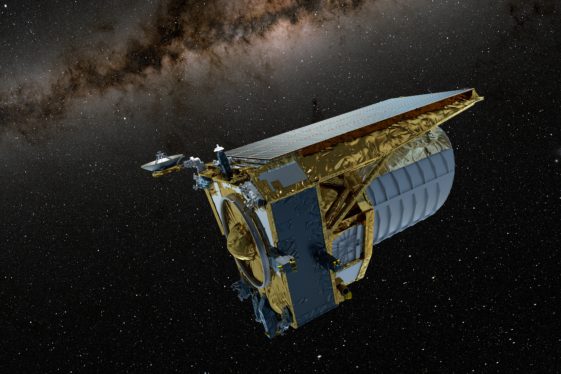On late Saturday morning, a SpaceX Falcon 9 rocket carrying the European Space Agency’s Euclid spacecraft successfully lifted off Cape Canaveral, Florida. The near-infrared telescope, named after the ancient Greek mathematician who is widely considered the father of geometry, will study how dark matter and dark energy shape the universe.
In addition to a 600-megapixel camera astronomers will use to image a third of the night sky over the next six years, Euclid is equipped with a near-infrared spectrometer and photometer for measuring the redshift of galaxies. In conjunction with data from ground observatories, that information will assist scientists with estimating the distance between different galaxies. As The New York Times notes, one hope of physicists is that Euclid will allow them to determine whether Albert Einstein’s theory of general relativity works differently on a cosmic scale. There’s a genuine possibility the spacecraft could revolutionize our understanding of physics and even offer a glimpse of the ultimate fate of the universe.
👋 Safe travels, #ESAEuclid!
The #DarkUniverse 🕵️♂️ detective ventures into the unknown. pic.twitter.com/JvWBpIz4Sx
— ESA's Euclid mission (@ESA_Euclid) July 1, 2023
“If we want to understand the universe we live in, we need to uncover the nature of dark matter and dark energy and understand the role they played in shaping our cosmos,” said Carole Mundell, the ESA’s director of science. “To address these fundamental questions, Euclid will deliver the most detailed map of the extra-galactic sky.”
With Euclid now in space, it will travel approximately a million miles to the solar system’s second Lagrange point. That’s the same area of space where the James Webb Space Telescope has been operating for the past year. It will take Euclid about a month to travel there, and another three months for the ESA to test the spacecraft’s instruments before Euclid can begin sending data back to Earth.
This article originally appeared on Engadget at https://www.engadget.com/europes-euclid-space-telescope-launches-to-map-the-dark-universe-175331413.html?src=rss




